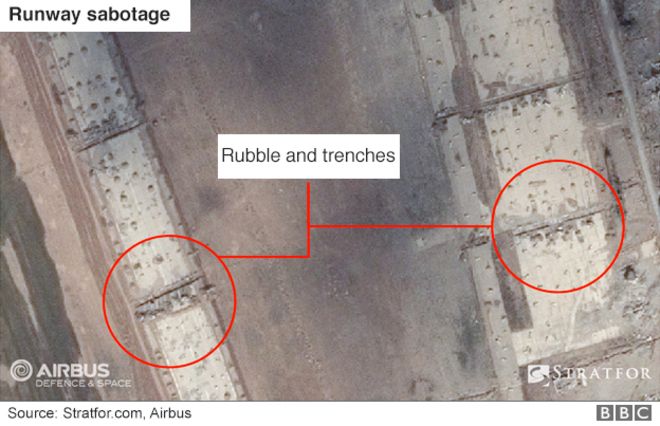Taking the airport is a key gain in the government's bid to drive IS militants from the western half of the city. Controlling it will help secure routes from the south.
Iraqi security forces, Kurdish Peshmerga fighters, Sunni Arab tribesmen and Shia militiamen, assisted by US-led coalition warplanes and military advisers, are involved in the operation, launched on 17 October 2016.
IS jihadists overran Mosul as they spread across much of northern and western Iraq two years earlier in 2014.
Retaking the whole of Mosul is expected to take several more months.
The UN said in late January that almost half of all the casualties in Mosul were civilians. At least 1,096 have been killed and 694 injured across Nineveh province since the start of October.
Territorial control: 24 February 2016
It took from mid-October until 8 January 2017 for Iraqi forces to advance as far as the River Tigris and another two weeks to gain full control of the eastern side of Mosul.
- Iraq forces seize Mosul airport from IS
- Iraq gaining momentum against IS
- Battle for western Mosul will be toughest yet
Territorial loss
Contradictory reports mean it is difficult to know exactly how much territory has been regained.
The maps shown here are based on expert analysis from two different sources, the Institute for the Study of War (for the recent advances) and IHS Conflict Monitor for territory.
According to analysis by IHS Conflict Monitor, IS fighters have been losing territory since the offensive began. However, gains slowed when Iraqi government forces met stiff resistance in the city of Mosul.
Territory changes: Oct 2016-Jan 2017
Mosul airport
Imagery, released by US geopolitical intelligence company Stratfor in October 2016, showed how IS fighters sabotaged much of the city's airport, with wide trenches carved into it and rubble placed along their lengths.
The barriers have been made out of concrete blocks and other rubble, Stratfor's analysis says, possibly from the walls of destroyed buildings.
All bridges linking the east and west of the city, across the Tigris river, have also been destroyed.
In the centre of the city, four of the five main bridges were put out of action in October and November by coalition air strikes, with the aim of limiting the jihadists' ability to resupply or reinforce their positions in the east.
The Old Bridge - the only remaining route open to vehicles in the centre of the city - was disabled in a US-led coalition air strike at the end of December.
Stratfor images show how the bridges have been damaged.
Al Jamhuriya Bridge
In November 2016 a US air strike damaged the bridge, but more recently it has been rendered impassable by further damage, shown below.
The UN has warned that the offensive to retake western Mosul could displace up to 400,000 civilians and involve a siege in the densely-populated old city.
It estimates 800,000 civilians are living in western districts. UN humanitarian co-ordinator for Iraq, Lise Grande, said half of them could flee their homes "in a worst case" scenario - twice the displacement seen in eastern Mosul.
Leaflets warning residents of the offensive have been dropped.
More than 160,000 people fled their homes in and around Mosul since the offensive began last October, but nearly 30,000 of them have returned to their places of origin.
The organisation says many of those who have fled Mosul and ended up in the camps have witnessed the deaths of relatives, friends and neighbours. Children are showing severe signs of trauma - such as excessive crying, mutism, bed-wetting and fear of leaving their parents.
Source www.bbc.co.uk/news/world-middle-east-37702442












 RSS Feed
RSS Feed